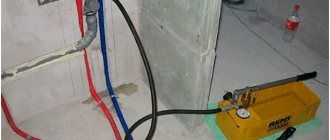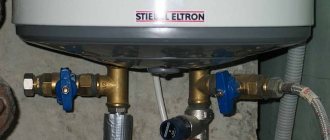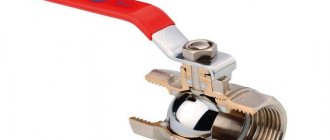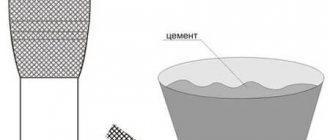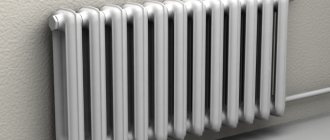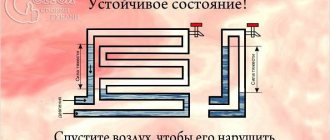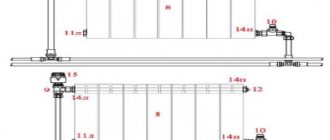Heating operating principle
First, you should consider how exactly the heating system works. It starts with the boiler room, where a boiler is constructed that runs on a specific fuel. It will be responsible for heating the water and its circulation.
Pipes are laid from the boiler to the rooms that need to be heated. In urban environments, the length of pipes can reach several kilometers, and they are laid underground so as not to disturb residents. In the rooms, pipes are connected to radiators (radiators), which heat the environment. Previously, radiators were made of cast iron, but now emphasis is placed on aluminum and brass due to their higher reliability: cast iron batteries quickly rusted and became unusable.
Central heating system operation diagram
After connecting the structure, it is filled with special water, which is called “coolant”. Its distinctive feature is that it contains a special alkali that prevents corrosion. This protects the inside of the battery from rust and extends its service life.
Interesting fact: if you fill the battery with ordinary water, it will become unusable within a couple of months.
When the pipes and radiators are completely filled with liquid, the boiler begins to heat it and also circulate in a circle so that stagnation does not form. An increase in the temperature of the coolant causes the battery to heat up and radiate heat, and the room is heated.
Depending on the weather outside, the boiler room regulates the temperature of the boiler, and consequently the temperature of the batteries. This is done by supplying fuel and adjusting operating modes. Previously, coal was most often used as fuel; now preference is given to gas, fuel oil and electricity sources.
Scheduled repairs
Do you want to clean your radiator? Exchange for a newer model or, vice versa (because, in your opinion, they are better)?
If you live in a private house, there are no problems. Just don’t forget that it’s better to fill the system right away and make sure that nothing is leaking anywhere.
If you live in an apartment and you have the opportunity to disconnect from the riser and change the battery yourself, do it. If not, it is better for you to contact the organization that services the heating network of your home so that its employees will shut off the heating system and release water from it centrally.
Material on the topic - (detailed step-by-step instructions are provided).
Draining a heating riser in a private house
The owner of a private house can drain the coolant himself at any convenient time. First he needs to find the taps that shut off the riser.
There are several types of heating systems. There are quite a lot of them, but their operating principles are similar. It is important to get the point:
- find the necessary shut-off valves;
- shut down the network;
- drain the coolant.
Let's look at the example of individual circuits.
The first picture shows a heating system with bottom supply. In it, the supply and return pipes are located in the basement or ground floor. The coolant is supplied from below, goes through the “idle” riser to the upper floor and returns through the heating devices through another riser. If the house has such a heating system, then two pipes located nearby are visible in the rooms.
Materials, equipment and procedure for draining water
To perform the necessary work, you will need a compressor, and of good performance, with a receiver for storing compressed air.
As you already understood, a car one is not suitable for these purposes.
If you are planning to drain used antifreeze, then you yourself understand that it is not worth draining it anywhere.
Clamps of the appropriate size for a reliable hose connection will also be needed.
Connect the hose from the compressor to the underfloor heating supply manifold.
The supply manifold may or may not have a special fitting in its design for filling the system under the hose. Therefore, the automatic air vent is unscrewed on the supply comb and a hose is connected through a suitable adapter and tightened with a clamp.
Arrangement of elements on the manifold for draining
- In the same way, connect the hose to the return manifold and lead it to the drainage point.
- Close the supply and return valves coming from the boiler in the manifold area.
- Using flow meters or valves (depending on your collector), close all underfloor heating circuits, except one, which, on the contrary, needs to be opened to the maximum.
- Turn on the compressor, open the valves or tap (depending on the type of comb) that are designed to fill and drain the system (those with hoses on them). At this moment, the coolant will begin to flow out of the drain hose under pressure. Wait until the water runs out and air comes out. At this point, pay attention to the pressure gauge on the compressor. If the pressure in the receiver at this moment is not high (1-3 atm), then close one of the taps on which the hose is attached (preferably, it would be a tap on the supply manifold, or if the pump is equipped with its own shut-off device, it is better to use it) . Wait for the pressure to rise to 5 atm. (no more) and blow out the floor loop under this pressure.
- Close the blown circuit and open the next one. Repeat the same procedure with him.
- In this way, drain the water from all underfloor heating circuits.
- For better efficiency, repeat the procedure after half an hour, since the remaining droplets of water in the pipe can connect with each other and eventually block the cross-section of the pipe in a certain place.
By following this method, you will solve the problem of how to drain water from a heated floor. The only problem is getting a compressor that can handle this task.
Self-pressure testing of underfloor heating systems
First launch of a warm water floor
Rules for installing a heated water floor based on a concrete screed
How to flush a heated floor heating system and how to completely flush the heating system in a private house with your own hands
Installation of water heated floors without concrete screed
Warm water floor system technology
When and why is water drained?
For any intervention in the heating circuit, which is associated with the replacement of its elements, it is necessary to drain the water from the heating system, because it is impossible to carry out work on a system filled with water.
The main list of works requiring the removal of coolant from pipelines and batteries is as follows:
- replacement of radiators;
- eliminating leaks;
- preventive maintenance, removal of contaminants;
- replacement of coolant.
Draining coolant from an autonomous system
The process of removing water from pipelines and batteries of an autonomous heating system of a private house does not require any permission or approval. What needs to be done next and how to drain the water from the heating system is described below.
The following simple rules must be followed:
- turn off the boiler (of any type) and allow the coolant to cool;
- close the cold water make-up valve;
- open the air valves (for a closed system).
In a properly installed system, there is a drain valve located at the lowest point of the system. It is usually located on the return pipe near the boiler. A hose is connected to the drain tap, through which water is removed from the circuit. After the water has been completely removed, you can begin to realize the purpose for which the coolant was drained. If heated floors are installed, then water can be removed from the pipelines only by connecting a compressor to the inlet pipe to displace it with air pressure.
However, situations often arise that do not require complete drainage of the water. For example, replacing or repairing a separate battery. The answer to the question - how to drain water from a heating battery - is simple if the design of the system has been carefully thought out and installed. To make this operation easy and quick, even when designing the circuit, it is necessary to provide for the possibility of cutting off the radiator from the system, without disrupting its operation.
Let's assume that all the recommendations have been followed, the battery is disconnected from the system by shut-off valves on it, but how to drain the water from the heating battery if there is a very significant amount of water in it, especially if the battery is cast iron. Therefore, it is necessary to install a container of sufficient volume to collect leaking water when disconnecting the radiator from the circuit. If the homeowner does not have the necessary skills, or does not understand how to drain the water from the heating system, then it is better to invite a heating specialist.
Draining water from heating systems of multi-storey buildings
If the apartment is located in a multi-story building, then such an operation is complicated by several factors. When performing repair or modernization work on the heating system, it is necessary to drain the water from the riser. To do this, you need approval from the company that services the heating of the house. Every resident should know where to go regarding heating if problems arise. The water drainage service is paid, and during the heating season it is extremely expensive and hourly. Therefore, it is better to plan the work for the summer period, when the coolant is drained, but permission to carry out the work and shut off the riser must be obtained.
How to protect your system from freezing
In addition to being able to drain the water, the system must be protected - at least partially - from frost. Not only a simple drain of water can save an individual water supply system from freezing - modern materials and technologies are at your service. To protect water shut-off valves from freezing of residual water, use faucets with ceramic parts and taps with rubber seals. The most resistant to water freezing are pipes, as we said above, not made of steel, but of low-density polyethylene (HDPE). Flexible plastic can withstand some increase in the volume of internal ice without collapsing, but it is still safer not to test the water supply for strength and remove all water from the water supply system before the onset of cold weather.
Lay water supply pipes from the well to the residential building along the bottom of a trench dug to a frost-free depth. This guarantees complete protection of the external water supply system from any frost. The pipes must be sloping towards the water source so that the return flow occurs unhindered. Protect pipes that go to the surface - for example, a short section of pipe from a trench into a house - with a heating cable.
Draining water from the water supply system for the winter will not be difficult if this function is initially included in the design of the external and internal water supply. A technically competent solution to this problem is only possible if the design and installation of pipes for individual water supply are entrusted to professionals.
Category: Water supply and heating
Emergency situation
By emergency we mean a case where the battery leaks. Again, if there is a tap that turns off the battery, turn it off and drain it; if not, you cannot do without calling a plumber.
The battery does not heat up
Cold water in the radiator, although the heating has been turned on a long time ago? Means, . In theory, your radiators should be equipped with a Mayevsky tap. If your battery is installed correctly (the angle in which the valve is installed should be slightly higher), then when you open the valve to bleed off excess air, only air will come out; as soon as the water starts flowing (don’t forget to immediately replace the jar), it means that the air has escaped and there is no more plug. If the radiator is installed completely horizontally, you may have to drain more water.
The rifar radiator has special drain taps
The Mayevsky crane is not installed? Perhaps it is better in this case to turn to specialists. Why?
Equipment tends to break down over time. Imagine that you managed to cope with coking and drain the water. But closing them is no longer possible.
Can you imagine what consequences this will lead to?
- Firstly, you will flood your neighbors, and you will still have to call a locksmith to turn off the heating in the entire house.
- Secondly, you will leave the entire house (or at least the entrance) without heating for quite a long time - until the consequences of your “amateur activity” are eliminated.
- In addition, if heating in your home is provided by an individual boiler, then the contract you concluded with the service organization states that it is prohibited to drain the water yourself. This is due to the loss of the required pressure level, which is signaled by special emergency sensors.
How to properly drain water from the system
If a summer water supply system was installed on the site and the water rose from a shallow well or well, then in addition to draining the water from the internal distribution system in the house, it is necessary to remove the pump so that the water in the water supply pipe does not freeze. Such simple systems usually do not provide any specialized means for convenient draining. If water is supplied to the house from a well with a caisson, then there is no need to lift the pump from the well - just open the drain valve above the head and the water from the water supply system will return to the well. The drain valve is located between the check valve and the accumulator. During the process of draining water, all taps at water collection points must be open. If there is a storage tank in the house, drain the water from it. Don’t forget about the summer water supply located outside - it will suffer from frost before anyone else.
To carry out effective drainage, water pipes must have a certain slope so that all the water is guaranteed to leave the system and not linger somewhere inside. A small amount of water remaining in the pipe and turning into ice can rupture the pipe and break the seal. Even a strong steel pipe will not be able to withstand the pressure of the ice that forms. Water from the water heater is also drained through a drain valve connected to the tee. The tap and tee must have a hose attachment to the check valve on the incoming water heating pipe. Another tee with a tap must be installed on the outlet pipe from the heater to supply air when draining water.
If for some reason the drain taps were not installed when installing the water supply system, and frost is about to hit, then you can remove water from the pipes using a compressor. Getting into the pipes through the tee, compressed air is able to displace all the water out. The compressor can be used even with a drain valve if you want to purge the system and make sure that there is not a drop of water left in it. Air blowing is especially important if the internal water supply in the house is made of hard plastic pipes, which, for the sake of design, are mounted strictly horizontally. In this case, complete drainage from the system is obviously not guaranteed and the use of purging is mandatory.
If you live in a country house permanently, and the heating system uses ordinary water rather than antifreeze, then before leaving for a long time in winter, it will also have to be drained so that the heating pipes and radiators do not fail. Of course, for such cases, various complexity and price options have been developed for emergency heating of the water supply system, heating system, or the room as a whole to a temperature of several degrees above 0 C. But all these methods do not guarantee complete protection, because the boiler or other heat source is mainly controlled using electronics, and in your absence the electricity may be turned off. In addition, electric heating equipment constantly turned on in the absence of owners increases the risk of fire. Therefore, the best, cheapest and most reliable protection of the heating system from freezing is the use of antifreeze.
But if it happens that instead of antifreeze, water is used as a coolant, then how to properly drain this water from the heating system? Turn off the boiler or close the distribution valve on the pipe leading from the riser. Close the valve through which water is supplied to the heating system. To drain water from the radiator system, use a hose of the required length to divert the water to a discharge point into the sewer or into the street. Open the drain valve on the radiator, and in the heating system, open the faucet with the air valve - this will speed up the drainage of water.
Where else can water remain? Don't forget to drain the water from all siphons (hydraulic seals). There are water seals in every home; they are located in curved sections of the drain pipe under sinks, under bathtubs, and in toilets. Water also remains in the coarse filter, in the main filter unit, in the washing machine and dishwasher and in the electric water heater. Simply put, before closing your dacha for the winter season, check all the devices to which water was supplied in the summer.
All work on draining water and preserving the individual water supply system must be carried out at a temperature not lower than + 5 C.
How to drain water from a battery - operating technology. How long to drain water from the battery
How to drain water from a heating battery in an apartment: what is this for?
Today, unforeseen situations often arise that force you to do unusual things, and therefore the question of how to properly drain water from a heating battery is increasingly asked by people who are not specialists in this profile.
Read more about how the process is carried out in the article.
Draining water from the battery correctly
If the battery is insufficiently heated in winter, when replacing or when pipes burst due to a temperature jump, it becomes necessary to drain the water from the battery. Almost all the time you have to do this yourself.
How to properly drain water from a battery? You just need to take into account some aspects of the process and follow the recommendations of experts.
First of all, it should be understood that water in an apartment building is drained from a section of the network, while in private houses the entire system is drained.
Draining water in the apartment
Draining water in the apartment must be done as follows:
- close the distribution valve that extends from the riser;
- Depending on the type of fittings, perform certain actions.
If you have a Mayevsky tap, you need to unscrew the key with a plastic handle or use a slotted screwdriver.
The battery drain valve has a side hole that faces the wall. It must be covered, otherwise dirty water from the battery system may flood the wall.
Next, you need to place a container under the hole and unscrew the screw until a characteristic sound appears - the hissing should soon disappear.
After this, you need to turn the screw out a little until water flows out of the hole.
Why is this being done? So that part of the air mixed with the coolant comes out during the process. When the stream becomes stable, it is necessary to tighten the system valve.
To check the correctness of the above actions, it is advisable to make sure that the previously cold part of the battery has warmed up. If this does not happen, then the water must be drained again.
If you have a regular tap, you need to attach a long hose to the valve, which should be enough to reach the sewer.
Then you need to open the battery valve completely to create a strong flow inside.
As the water speed increases, the air comes out faster, but it is better to take into account the network pressure and the power of the air plug.
It is necessary to control the draining process until the cold sections of the battery begin to warm up. This usually takes quite a long time.
In the absence of fittings, it is advisable to resort to the help of specialists, especially if you are draining water from a system of cast iron Soviet batteries.
If there is a cast iron radiator in the apartment, then you need to unscrew the nut and make sure that the gasket does not leak after tightening it.
Draining water in a private house
For modern sectional batteries, you need to slowly unscrew the top plug 1-2 turns.
Draining water in the house should be done as follows:
- disconnect the boiler from the electricity supply;
- turn off the tap through which water flows to the boiler;
- perform the steps above, depending on the type of reinforcement.
It is imperative to drain water from all devices to which it is connected. You should not forget about water seals - these are curved sections of drain pipes under various types of plumbing fixtures.
Video:
Water can also remain in system cleaning filters, various types of household appliances (washing machines and dishwashers), including electric water heaters.
Therefore, for the draining process, it is necessary to provide free access to them. The temperature should be around +5°C.
As a rule, the process of draining water from batteries in an apartment or private house is not particularly difficult.
The procedure can be completed independently, but if you don’t have a Mayevsky tap, you should still turn to specialists, otherwise it could end up flooding your neighbors with water, leaving the house without heating for a long time and filing a lawsuit.
System frost protection
There are various options for emergency heating systems for houses. They are based on the fact that if the owners of the house are away for a long time, the heating system is controlled electronically.
This is a sensor that is installed in the room and reads the temperature, and a receiver that communicates directly with the boiler. An important condition for such automation is the need for constant access to the Internet.
Another option for freeze protection is to use antifreeze.
However, if the system consists of zinc pipes, then this liquid cannot be used in the process.
By interacting with zinc, antifreeze loses its properties. In addition, it has a heat capacity lower than that of water, therefore requiring the installation of a more powerful radiator and circulation pump.
To prevent residual water from freezing, it is recommended to use faucets with ceramic elements and taps with rubber seals in the system.
In addition, it is better to use pipes made of low-density polyethylene (HDPE). They have higher performance characteristics, and when the water freezes in the pipe, complete tightness is maintained. In this case, no damage to the pipe itself is observed.
A few words should be said about the safety of the external water supply system. Correctly selected depth of soil non-freezing is an important condition for laying a water supply system.
The required slope of the pipes facilitates unhindered reverse drainage of water.
If the pipes go outside, then a heating cable is needed, which allows you to maintain the required temperature in the system and protects the pipes from condensation.
You need to turn it on at a temperature of -5° C and adjust the heating. If the temperature outside drops below the specified value, and you did not have time to turn it on, you will have to wait until the ice that has formed melts.
Proper heating protection from freezing and proper care will ensure that the system will serve you for many years.
However, it should be said that the entire process of plumbing work requires time and attention and is necessary to avoid emergency situations.
Therefore, if you still have questions about how to properly drain water from a heating battery, it is better to contact a specialist.
stoydiz.ru
Methods for draining water from heating radiators in an apartment
Radiator
With the onset of October, the temperature, both outside and in apartments, gradually decreases. Each of us thinks: “the main thing is to hold out until the start of the heating season.” However, the situation does not change from year to year. The media announce that heating was turned on in houses on time and without delays, but many people’s radiators remain cold. It’s even more offensive when the heat still reaches the neighboring apartments, but not yours.
The reason for this unpleasant situation is the formation of air jams along the riser. These plugs clog the radiators on different floors of the building and lead to the fact that hot water, carrying the long-awaited warmth, cannot get through them. There are several ways to solve this problem, which I would like to consider below.
Options for solving the problem
Air locks can be eliminated. To do this, it is necessary to bleed the air and drain the water from the battery, which will allow the free space to be filled with incoming hot water. It is important to determine who will do this (you or a representative of the service organization).
The best option is to leave an application with the municipal unitary enterprise or homeowners association and wait for the mechanics. However, the wait may take up to several weeks. Many people want to resolve this issue as quickly as possible, so they independently manage the heat supply to the apartment.
Advantages and disadvantages of self-draining water
The main disadvantages include the following:
Damage to battery drain mechanisms
As a rule, any equipment tends to “age”, and those connected to water also become coked over time. If you open the battery drain mechanisms, let out the air and drain the water on your own, then you may not be able to close them. And this can lead to flooding of the neighbors, and, naturally, the heating will disappear in the entire entrance until the fault is eliminated.
Loss of water pressure in batteries
When heating is provided by individual boilers, many service organizations prohibit draining water from the risers themselves. Since when there is a loss of pressure, emergency control sensors begin to signal
rinnipool.ru
Replacing a radiator in an apartment building
If you only need to change the radiator for repairs, then every apartment owner must know how to properly shut off the radiator.
If the system in the house was installed in good faith, then this possibility certainly exists. By closing the shut-off valves at the battery inlet, which stops the supply of water to the radiator, but does not stop the circulation of water in the heating system, you can begin to replace the battery. Further actions depend on the presence of an outlet valve. If there is one, then the water is drained through the tap, but more often it is not, so the drain is performed when the inlet or outlet pipe is disconnected. You should place a container for water so as not to flood your neighbors.
Knowing how to shut off a heating battery is also necessary to prevent various emergencies, such as a severe leak due to the destruction of the radiator. Every owner needs to know the phone number of the organization where to contact about heating immediately in the event of an emergency.
If a single-pipe heating scheme is used, then a bypass must be installed. Every apartment owner should have a clear and precise understanding of how to shut off the heating radiator in this case.
With such a circuit diagram, the following actions are carried out:
- the bypass valve opens completely;
- close the shut-off valves on the battery on both sides.
Having completed these operations, you can begin to remove the radiator from the system.
After replacing the battery, sealing the connections and tightening the locknuts, gradually open the valves at the battery inlet and outlet.
At the same time, the Mayevsky tap opens and the bypass closes. Slowly filling the battery prevents water hammer, and the air from the battery is released through the Mayevsky tap until water appears. This will mean that the battery is filled with liquid, the air has been removed, and the shut-off valves on the battery can be opened completely.
Is it possible to do without draining the riser?
Minor repairs or simply replacing the battery do not require draining the entire heating system. In almost all apartments, you can shut off a separate radiator without affecting the general circuit.
1. Turn the corresponding tap on the heating riser and shut off the coolant supply.
2. Open the outlet valve on the radiator or unscrew the cap using an adjustable wrench. Drain the water into a container.
If there is neither a plug nor a tap, then disconnect the heating battery and drain the coolant. This will turn out to be more difficult and dirtier, but there is no other way.
Sometimes, for minor repairs, you do not need to drain the water, but simply shut off its supply to the internal circuit.

